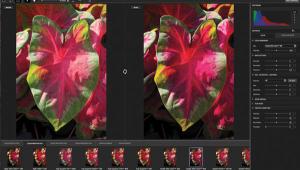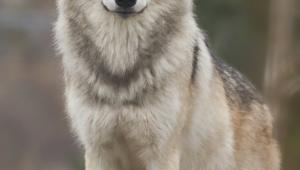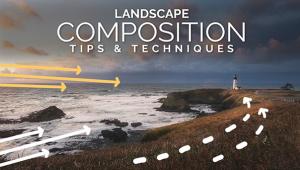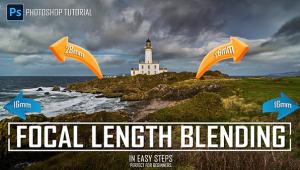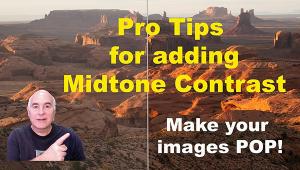Digital Life Preservers ; How To Organize, Archive, And Protect Your Valuable Photos
They're both round and have a hole in the center. But are CDs and DVDs really digital life preservers? How long will they last? What are the safest and most reliable brands? What about hard drives--how safe are they? What can you do to best preserve your digital images and data? What are the best media to buy, how should you store them, and how do you archive and retrieve your images? In this article, I'll address the latest thinking on these issues and tell you how professional photographers are dealing with them.
Does it seem that your hard drive is filling up with digital image files faster
than the speed of light? That's not surprising as the size of digital
camera files increases and film and print scanners climb to higher and higher
resolutions. Whether your digital pictures are raw, JPEG, or TIFF files from
digital cameras, scans from prints, negatives, or slides, or corrected and enhanced
versions saved in your image-editing software's format such as Adobe Photoshop
PSD, you want to know the best way to keep them safe. You also need to index
them so you can find what you need easily. Among the issues to consider are
which software and hardware to use, as well as convenience and speed of both
archiving and retrieval.
Many pros now copy digital image files to CD or DVD for backup and storage.
But then, how do you keep track of them? Which pictures are on which disk? What
is the best format?
CD-R Compact Discs
Both CDs and DVDs are optical storage media. To record your photos or other
digital data, a CD writer or "burner" uses a laser which etches
a pattern onto the reflective underside of the disc in a long spiral format.
This pattern can then be read by a CD drive using an optical sensor which detects
the encoded data.
For the past few years, CD-R compact discs have been widely used. With a storage
capacity of 650-700MB each, their cost has dropped to $0.30 per disc or less
in bulk for the top-quality types recommended for archiving. CD burners have
dropped in price and increased in speed to where the top models now claim speeds
of 52x and above. Often, an entire disc can be written and verified (checked
for accuracy by the authoring software) in 5 minutes or so. Always verify. Be
sure that the disc you use is rated at the speed you'll be writing at
or higher.
However, as digital file sizes increase, fewer and fewer images will fit on
each CD-R. For example, 35mm film scans I've done with the Minolta DiMAGE
Scan Elite 5400 made at 5400dpi resolution with 16-bit color depth take up about
110MB. I can only fit six of them on a 700MB CD. As a result, many high-res,
high-volume shooters have moved to DVD discs for archiving.
DVD-R And DVD+R Digital Video Discs
Despite its name, DVD is not exclusively for digital video. Any digital file
can be stored on a DVD. DVD is rapidly becoming the professional's disc
of choice to back up digital files. The same size and appearance as a CD, the
most common DVD disc will hold a whopping 4+GB (gigabytes) of data. Although
the discs are labeled "4.7GB," because of formatting requirements,
the space actually available for storage is reduced to about 4.2-4.37GB, depending
on the software and the disc. Double-sided discs double the labeled capacity
to 9.4GB (but at a slow speed of 2.4x), and I have no doubt that the capacity
and speed will increase even further in the future.
As opposed to the 700MB of digital pictures that a CD can hold, a 4.7GB DVD
can store about six times more. As far as cost, quality 4.7GB DVD discs on sale
can go to below $0.50 each. At an 8x recording speed, I can write 4.2GB of photo
files to one of these DVD discs in about 7.5 minutes. Note that although they
may look identical, the speed ratings for CDs and DVDs are not the same. At
press time, the fastest DVDs were rated at 16x. For comparison, check the estimated
times to write a given file size.
File Formats
You've no doubt seen a dizzying array of file format names for CDs and
DVDs. Let's sort them out. With CD-R, which stands for Compact Disc-Recordable,
you can record the disc all at once or in several "sessions" at
different times, with appropriate software. The advantage of writing in sessions
is that if you only have say, 300MB of pictures to back up, you can archive
them now, then wait until you do another shoot and have another 300MB to archive.
The second batch can be written to the same disc in a second session. Once any
data is recorded on a CD-R though, it cannot be changed or written over.
On the other hand, the CD-RW format, or Compact Disc-Rewritable, refers to discs
that you can write to and later erase many times. These discs are not as stable
as most CD-Rs and are not intended or recommended for long-term storage. For
more information about both types of CDs, check out www.cdrfaq.org on the web.
Another issue is the format in which data is stored on the disc. While Macs
can generally read both formats, Windows machines can't read Mac files
without special software. For this reason, some pros archive their pictures
on disc using the multi-platform ISO 9660 format which can be read by Mac, Windows,
UNIX, and other systems. In order to do this, you must have CD/DVD writing software
that offers this option. Several choices are discussed here.
In the DVD realm, there are currently two viable formats of recordable DVDs,
DVD-R and DVD+R. Most manufacturers make both types and the prices are the same.
It's a matter of time to see which one takes precedence. Like a CD-R,
with both DVD-R and DVD+R, once you write data to the disc, it cannot be altered
or erased. Although technically it is possible to write multiple sessions on
these discs, a standard has not yet been established. If your DVD authoring
software doesn't support multiple sessions, or if you simply want to write
to each DVD only once, consider this approach. Create a separate folder on your
hard drive and gradually fill it with photo files you want to back up until
you reach about 4.2GB. Then burn the DVD-R or DVD+R disc.
DVD rewritable discs include: DVD-RW, DVD+RW, and DVD-RAM. Like CD-RW discs,
these can be written to and erased many times. Also like CD-RW, they are not
known for long-term stability and are not intended or recommended for archiving.
Double Your Security
Whether you're writing a CD or a DVD, always make two copies. Keep one
on premises and store one off-site. This way you have extra insurance against
the failure, theft, fire, or other loss of one of your backups. Always use top
brand name discs that are designed for archiving, as described here in the section
on longevity.
Hardware And Software For Disc Writing
The most popular programs for burning CDs and DVDs are Roxio's Toast 6
Titanium on the Mac, and for Windows, Roxio's Easy Media Creator 7.5,
and Nero 6.6 Ultra Edition from Nero AG. Most sell for under $100. Both Roxio
products and Nero are easy to use. Further options include Sonic's MyDVD
Studio 6.1 for Windows which has been well reviewed; it is said to be simple
to use, and will write sessions on a DVD. For the Mac, NTI's Dragon Burn
4 writes multiple sessions on DVD. All will write to all the formats of discs
described previously, and most offer multiple features to burn not only data
but music and video as well, including slide shows with music. Some even include
back-up software, and the newest versions often include LightScribe software
to burn labels on the disc with the burner's own laser. For this new type
of labeling, both the disc and the CD burner must support LightScribe.
 |
|
|
I have used Toast through several versions and have found it to be easy, fast,
and reliable. Toast 6 is even more streamlined and simplified than its predecessors.
Should you want to delve into more technical features and settings, they are
only a click away.
Due to the multiple DVD formats currently in use, I recently purchased a combination
CD/DVD burner that can read and write all the formats. This way, I'm prepared
for whatever the future holds (for a year or so anyway). LaCie offers a number
of reliable CD/DVD writers such as the LaCie d2 DVD±RW, an external dual-layer
(up to 8.5GB) 16x speed drive available with both FireWire and USB connectivity,
for both Mac and Windows machines. Note that 16x is the top speed for a 16x
single-layer disc--dual-layer speed is 2.4x.
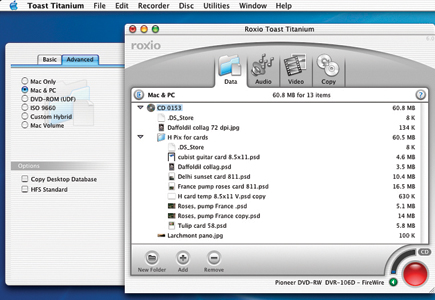 |
|
|
At press time, this drive was bundled with Toast 6 and included LightScribe technology to burn labels on the disk at a street price under $200. DVD burners will also write CDs. If you have several computers or even just a desktop and a laptop, an external drive makes it easy to share files and work on images with any of your machines. Internal drives can be much less expensive if you have only one computer or don't need to transfer files often between machines.
 |
|
|
|
 |
|
|
I do recommend that you get a fast writer, at least 8x for DVD and 40x or faster for CD. Also be sure that your media is fully compatible with your burner (for maximum speed, use 16x DVD media in a 16x DVD burner), and that you have selected media that most drives can read.
 |
|
|
Longevity
How secure are CDs and DVDs? How long will they last? These are questions that
are not easy to answer. Like traditional photo media, they are sensitive to
heat, humidity, and light. Top manufacturers like Mitsui, Verbatim, Maxell,
Memorex, TDK, and others offer premium discs with protective coatings and special
dyes that they state will last 50-100 years, depending on the brand. Among these
are Verbatim's DataLifePlus, Maxell Pro, and TDK's HardHat. Verbatim
states that its double-sided disks will last 50 years. Note that these companies
offer different grades of discs--you want the most archival.
Here's an insider tip: Several major software and equipment manufacturers
that I've spoken with use Verbatim discs for their products. Mitsui, the
company that manufactures Verbatim media, says that it does extensive heat and
humidity testing in order to determine what dyes and other materials to use
to obtain the best longevity. Last year, Delkin introduced "Archival Gold"
CD-R disks that it claims will last for 300 years, based on accelerated aging
tests, at a price of about $1.40 each in bulk.
 |
|
|
Last fall, the US National Institute of Standards and Technology (NIST) published
tests of CD and DVD media subjected to stress from temperature, humidity, and
light (www.itl.nist.gov/div895/gipwg/StabilityStudy.pdf). The tests showed that
for CD discs, a gold and silver alloy coating and phthalocyanine dye combo were
superior (available from Mitsui and Delkin). For DVDs though, results were unclear
because of trade secrets and variations regarding dyes and coatings. Here's
one of the conclusions: "Results suggest that [CD and DVD] media will
ensure data is available for several tens of years and therefore may be suitable
for archival uses. Unfortunately, it is very difficult for customers to identify
these more stable media." However, the NIST and the Library of Congress
are now collaborating to determine the life expectancy of DVD recordable media
and to develop a test which media manufacturers can use to assign an archival-quality
grade to their product. When this will be accomplished is anybody's guess.
In the meantime, here are some things to keep in mind:
Even with top brands, one professional photographer experienced a failure rate
of 3 percent after three years with CD-R discs which had all been verified at
the time of burning and carefully stored. That's why it's imperative
to make at least two copies of any back-up disc. Personally, I try to do them
on different brands or, if using the same brand, from two different packages
to minimize the risk of manufacturing error.
About a year ago, a Dutch magazine tested some name and off-brand discs. After
only a few months of dark storage, some discs were totally useless. A brand
name manufacturer asked to see two of its discs that had failed. They acknowledged
the failure and attributed the problem to manufacturing flaws. Please, always
make at least two backups!
 |
|
|
There's another issue of longevity that has nothing to do with quality control. Got any 8-track tapes? Got anything to play them on? Technology is changing at a frenetic pace. When, at some point in the not-too-distant future, you see that CD and/or DVD is being replaced by another format, transfer your back-up discs to the new media.
- Log in or register to post comments
